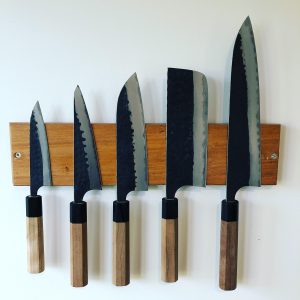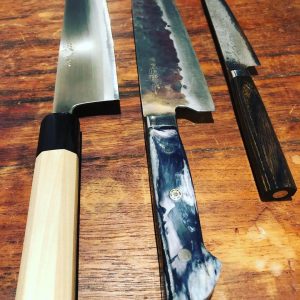Tom Belien, of Artisan Knives, has been involved in the culinary scene across the world—from Belgium to France, to the U.K., and now, New Zealand. At the end of 2013, Belien decided that he wanted a change from the hospitality industry, and wanted to work for himself. “After I bought my first Japanese hand-forged knife,” said Belien, “I knew it was something special and I recognised it as having a potential to be an avenue to make a living off.”
“I started Artisan Knives with only 15 knives in stock.” Through his work, and a partnership with Shibata san from Masakage, Belien began learning about the world of sharpening and knife production. “I met a lot of wonderful customers with some great stories, and it was very motivating to hear how they use, cherish and enjoy their knives they bring me to sharpen or purchased from me.”

Belien specialises in Japanese-style knives. The processes involved in their craft is delicate and steeped in tradition. Japanese knives have a cladding steel and a cutting steel in the centre. This way, one can use a hard cutting steel protected with a layer of softer cladding steel on both sides. Welding both the steels together is the first thing to do, where the general shape is created through hammering. This will make the grain structure of the steel finer and help with the sharpening capability. Shaping and pounding the steel is the next step until a rough knife shape is created. Here measurements are taken to ensure the blade is hammered to specification. Trimming the blade to get a nicer looking shape is followed by grinding, bevelling, and creating a finish. Belien also described the importance of heat treatment. This is where the blade is heated to very precise temperatures and quickly cooled down to optimise the hardness of the blade. After that, the knives are left to rest for a few months, so the stresses caused by the forging can settle. After a final round of checking and straightening, the knives can be sharpened, and the handles fitted.
The importance of having quality chef knives shone through in conversation with Belien. Not only does it make the physical process of cutting more comfortable, it means the food is better presented, and the chefs are saving time as they work faster and more productively with good quality knives. Belien described two must-haves to look out for when choosing a chef knife—sharp out the box, and thickness behind the edge. “Sharpness does not need to be explained, but a thin knife cuts a lot easier through hard and dense vegetables, requiring less force and making it more pleasant to use.”

“I filter first on the length—24cm is my preferred length—then steel type, as you want something with a high carbon content. This gives it a fine grain structure which is good for sharpness and edge retention. Aesthetics are the last consideration.”
“A chef should have, in my opinion, two chef knives (21-24cm), one for robust work, and the other for finer work. They should also have a pairing knife for smaller ingredients, a good slicing knife, with a long blade, a serrated/bread knife, a knife for working with fish, and perhaps a butchering knife, if there is a need for it.” Bottom line, Belien recommends investing in quality knives where possible, but remember, don’t put them in the dishwasher.







